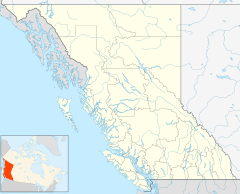Metlakatla, British Columbia facts for kids
Quick facts for kids
Metlakatla, British Columbia
|
|
|---|---|
| Country | |
| Province | BC/BCE |
| Area code(s) | 250, 778 |
Metlakatla, British Columbia is a small community in British Columbia, Canada. It is one of seven Tsimshian villages in the province. The community is located near Prince Rupert, British Columbia, at Metlakatla Pass. The name Maxłaxaała means "saltwater pass" in the Tsimshian language. Unlike other Tsimshian villages, Metlakatla is not linked to just one specific Tsimshian family group.
Contents
A Look at Metlakatla's Past
The Metlakatla site was traditionally a winter village for the "Nine Tribes" from the lower Skeena River. These tribes have mostly been based at Lax Kw'alaams, B.C., since 1834.
In 1862, a Christian missionary named William Duncan started a special community in Metlakatla. About 350 Tsimshian people from Lax Kw'alaams joined him. People from other Tsimshian tribes also became part of this new community.
The Smallpox Epidemic of 1862
Soon after the community began, a serious smallpox epidemic spread across the North Coast. Duncan worked hard to keep Metlakatla safe. He did not allow anyone showing signs of smallpox to enter the village. Because of his efforts, Metlakatla was mostly protected from the disease. In other places, many people died. For example, over half of all Indigenous peoples from Puget Sound to the Alexander Archipelago passed away.
Duncan used this event to encourage people to become Christian. He told them that the disease was a punishment for sins. He said that those who changed their ways and were baptized would be saved.
Changes and Challenges
After the epidemic, some of Duncan's followers, including Paul Legaic, a powerful Tsimshian chief, continued to live in both Lax Kw'alaams and Metlakatla. They also kept some of their traditional culture alongside Christianity. Other missionaries, like Robert Tomlinson and William Henry Collison, also worked in Metlakatla. Collison wrote a book about his experiences called In the Wake of the War Canoe.
By 1879, Metlakatla's population had grown to about 1,100 people.
Duncan had his own way of practicing Christianity. This led to disagreements with the Church Missionary Society in 1881. He then started his own "Independent Native Church." In 1887, Duncan and about 800 Tsimshian people from Metlakatla left. They traveled by canoe to start a new community called "New" Metlakatla, Alaska.
After Duncan left, about 100 people stayed in "Old Metlakatla." William Ridley, an Anglican bishop, became their leader.
Fires and Historic Recognition
In July 1901, a fire destroyed St. Paul's Church in Metlakatla. This church was built by Duncan in 1874 and was said to be very large. Some people believe the fire was started by Tsimshians from Alaska, possibly on Duncan's orders. This included Peter Simpson, who later became a well-known Indigenous rights activist in Alaska. This sad event led to Bishop Ridley leaving for England in 1905.
A second St. Paul's Church was built in 1903, but it also burned down 11 years later.
In 1972, Metlakatla Pass was named a National Historic Site of Canada. This means it is an important place in Canadian history.
Since those times, Metlakatla, B.C., has remained one of the smaller Tsimshian communities. In 1983, it had 117 residents. The community relies on the nearby city of Prince Rupert for many things. Most people in Metlakatla are still Anglican.
Modern Discoveries
In November 2016, a study was published that connected the DNA of ancient Indigenous people to their descendants in the Metlakatla First Nation. The study looked at people who lived in the area of modern-day Prince Rupert, British Columbia between 1,000 and 6,000 years ago. This study proved what the Metlakatla people had always said in their oral history: that they had lived in this region for thousands of years.
William Duncan's Rules for the Community
When William Duncan started the Metlakatla community, he set up a list of rules for people to follow. These rules were meant to guide how people lived and behaved:
- Give up their traditional spiritual practices (called Ahlied or Indian devilry).
- Stop calling in traditional healers when sick.
- Stop gambling.
- Stop giving away their property for show (this refers to the potlatch, a traditional ceremony).
- Stop painting their faces.
- Stop drinking alcohol.
- Rest on Sundays.
- Attend religious lessons.
- Send their children to school.
- Be clean.
- Work hard.
- Be peaceful.
- Be fair and honest when trading.
- Build nice houses.
- Pay a village tax.
Notable People from Metlakatla
Here are some important people who came from Metlakatla:
- Benjamin A. Haldane: A photographer.
- Paul Legaic: A powerful hereditary chief.
- Rev. Edward Marsden: A missionary.
- Odille Morison: A linguist (someone who studies languages) and a collector of artifacts.
- Peter Simpson: An activist who worked for Indigenous rights.


